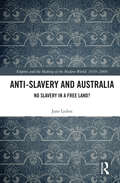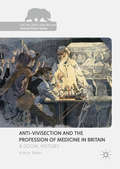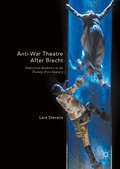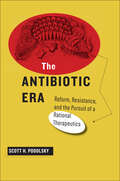- Table View
- List View
Anti-Slavery and Australia: No Slavery in a Free Land? (Empire and the Making of the Modern World, 1650-2000)
by Jane LydonBringing the histories of British anti-slavery and Australian colonization together changes our view of both. This book explores the anti-slavery movement in imperial scope, arguing that colonization in Australasia facilitated emancipation in the Caribbean, even as abolition powerfully shaped the Settler Revolution. The anti-slavery campaign was deeply entwined with the administration of the empire and its diverse peoples, as well as the radical changes demanded by industrialization and rapid social change in Britain. Abolition posed problems to which colonial expansion provided the answer, intimately linking the end of slavery to systematic colonization and Indigenous dispossession. By defining slavery in the Caribbean as the opposite of freedom, a lasting impact of abolition was to relegate other forms of oppression to lesser status, or to deny them. Through the shared concerns of abolitionists, slave-owners, and colonizers, a plastic ideology of ‘free labour’ was embedded within post-emancipation imperialist geopolitics, justifying the proliferation of new forms of unfree labour and defining new racial categories. The celebration of abolition has overshadowed post-emancipation continuities and transformations of slavery that continue to shape the modern world.
Anti-Slavery and Australia: No Slavery in a Free Land? (Empire and the Making of the Modern World, 1650-2000)
by Jane LydonBringing the histories of British anti-slavery and Australian colonization together changes our view of both. This book explores the anti-slavery movement in imperial scope, arguing that colonization in Australasia facilitated emancipation in the Caribbean, even as abolition powerfully shaped the Settler Revolution. The anti-slavery campaign was deeply entwined with the administration of the empire and its diverse peoples, as well as the radical changes demanded by industrialization and rapid social change in Britain. Abolition posed problems to which colonial expansion provided the answer, intimately linking the end of slavery to systematic colonization and Indigenous dispossession. By defining slavery in the Caribbean as the opposite of freedom, a lasting impact of abolition was to relegate other forms of oppression to lesser status, or to deny them. Through the shared concerns of abolitionists, slave-owners, and colonizers, a plastic ideology of ‘free labour’ was embedded within post-emancipation imperialist geopolitics, justifying the proliferation of new forms of unfree labour and defining new racial categories. The celebration of abolition has overshadowed post-emancipation continuities and transformations of slavery that continue to shape the modern world.
Anti-Slavery Political Writings, 1833-1860: A Reader
by C. Bradley ThompsonThe abolitionist movement in 19th century America led directly to the end of slavery in the United States. This collection of more than 20 original documents including speeches, editorials, books and fiction, captures the deep ideological divisions within the abolitionist movement.
Anti-Slavery Political Writings, 1833-1860: A Reader
by C. Bradley ThompsonThe abolitionist movement in 19th century America led directly to the end of slavery in the United States. This collection of more than 20 original documents including speeches, editorials, books and fiction, captures the deep ideological divisions within the abolitionist movement.
Anti-Social Behaviour in Britain: Victorian and Contemporary Perspectives
by Sarah PickardThis comprehensive, interdisciplinary collection examines diverse forms of anti-social behaviour in Victorian and contemporary Britain, providing a unique comparison of the methods which have been employed by governments to control it.
Anti-Southern Racism and Education in Post-War Italy (Routledge Studies in the Modern History of Italy)
by Grazia De MicheleThis book investigates the racism against Southern Italian children attending North-Western primary schools between the 1950s and the 1970s. Turin serves as the main case study, having become the "third Southern city" after Naples and Palermo during the considered period. Far from being a new phenomenon, racism against Southern Italians gained renewed prominence in the context of the post-war mass internal migrations, becoming one of the pillars of the process of nation-rebuilding. However, in spite of its relevance, it has not received the attention it deserves. By drawing on a wide range of sources – printed, archival, photographic and oral – and situating itself at the intersection of history of racism, of education, of psychiatry, and of psychology, the book aims to fill this gap and to add to the debate on the borders that nation-states establish to control the access to power of the different groups inhabiting their territories. Its interdisciplinarity makes it suitable for students and researchers across a variety of subject areas.
Anti-Southern Racism and Education in Post-War Italy (Routledge Studies in the Modern History of Italy)
by Grazia De MicheleThis book investigates the racism against Southern Italian children attending North-Western primary schools between the 1950s and the 1970s. Turin serves as the main case study, having become the "third Southern city" after Naples and Palermo during the considered period. Far from being a new phenomenon, racism against Southern Italians gained renewed prominence in the context of the post-war mass internal migrations, becoming one of the pillars of the process of nation-rebuilding. However, in spite of its relevance, it has not received the attention it deserves. By drawing on a wide range of sources – printed, archival, photographic and oral – and situating itself at the intersection of history of racism, of education, of psychiatry, and of psychology, the book aims to fill this gap and to add to the debate on the borders that nation-states establish to control the access to power of the different groups inhabiting their territories. Its interdisciplinarity makes it suitable for students and researchers across a variety of subject areas.
The Anti-Tank Rifle (Weapon)
by Steven J. Zaloga Johnny Shumate Alan GillilandThe emergence of the tank in World War I led to the development of the first infantry weapons to defend against tanks. Anti-tank rifles became commonplace in the inter-war years and in the early campaigns of World War II in Poland and the Battle of France, which saw renewed use in the form of the British .55in Boys anti-tank rifle - also used by the US Marine Corps in the Pacific. The French campaign made it clear that the day of the anti-tank rifle was ending due to the increasing thickness of tank armour.Nevertheless, anti-tank rifles continued to be used by the Soviets on the Eastern Front with two rifles, the 14.5mm PTRS and PTRD, and were still in widespread use in 1945. They served again with Korean and Chinese forces in the Korean War, and some have even appeared in Ukraine in 2014–15. Fully illustrated and drawing upon a range of sources, this is the absorbing story of the anti-tank rifle, the infantryman's anti-armour weapon during the world wars.
The Anti-Tank Rifle (Weapon)
by Steven J. Zaloga Johnny Shumate Alan GillilandThe emergence of the tank in World War I led to the development of the first infantry weapons to defend against tanks. Anti-tank rifles became commonplace in the inter-war years and in the early campaigns of World War II in Poland and the Battle of France, which saw renewed use in the form of the British .55in Boys anti-tank rifle - also used by the US Marine Corps in the Pacific. The French campaign made it clear that the day of the anti-tank rifle was ending due to the increasing thickness of tank armour.Nevertheless, anti-tank rifles continued to be used by the Soviets on the Eastern Front with two rifles, the 14.5mm PTRS and PTRD, and were still in widespread use in 1945. They served again with Korean and Chinese forces in the Korean War, and some have even appeared in Ukraine in 2014–15. Fully illustrated and drawing upon a range of sources, this is the absorbing story of the anti-tank rifle, the infantryman's anti-armour weapon during the world wars.
Anti-Vaccination and the Media: Historical Perspectives
by Allison CavanaghThis book explores narratives of vaccine hesitancy using samples from the UK press, and looks at the ways these have changed between the 1950s and the present. The work draws on a variety of research instruments including semantic network analysis and analysis of metaphor to provide a rich description of anti-vaccine narratives in different historical periods. The work considers the ways that concerns about and resistance to inoculation were informed by cultural and social pressures in two case studies, firstly that of polio in the 1950s and secondly the so called ‘pertussis crisis’ of the 1970s, wherein a period of social activism and newspaper campaigning led UK and US governments to offer compensation schemes for vaccine damaged children. The studies chosen provide a detailed comparison of the politics of childhood inoculation over two eras in the UK. Chapters also cover the use of metaphor and representational analysis in health communication, comparing ways in which the work of Moscovici, Sontag and other theorists can be used to provide complementary insights, and the affordances and concerns around the use of ‘big data’ analyses in historical work. The work also features discussion of the implications of the findings for approaches to more recent vaccination crisis points. This book argues that anti-vaccination narratives, far from showing a stable and coherent set of concerns, are highly mutable. The work compares anti-vaccination and conspiracy theory narratives, drawing out areas of continuity and schism.
Anti-Veiling Campaigns in Turkey: State, Society and Gender in the Early Republic
by Sevgi AdakThe veiling and unveiling of women have been controversial issues in Turkey since the late-Ottoman period. It was with the advent of local campaigns against certain veils in the 1930s, however, that women's dress turned into an issue of national mobilisation in which gender norms would be redefined. In this comprehensive analysis of the anti-veiling campaigns in interwar Turkey, Sevgi Adak casts light onto the historical context within which the meanings of veiling and unveiling in Turkey were formed. By shifting the focus from the high politics of the elite to the implementation of state policies, the book situates the anti-veiling campaigns as a space where the Kemalist reforms were negotiated, compromised and resisted by societal actors. Using previously unpublished archival material, Adak reveals the intricacies of the Kemalist modernisation process and provides a nuanced reading of the gender order established in the early republic by looking at the various ways women responded to the anti-veiling campaigns. A major contribution to the literature on the social history of modern Turkey, the book provides a complex analysis of these campaigns which goes beyond a simple binary between liberation and oppression.
Anti-Veiling Campaigns in Turkey: State, Society and Gender in the Early Republic
by Sevgi AdakThe veiling and unveiling of women have been controversial issues in Turkey since the late-Ottoman period. It was with the advent of local campaigns against certain veils in the 1930s, however, that women's dress turned into an issue of national mobilisation in which gender norms would be redefined. In this comprehensive analysis of the anti-veiling campaigns in interwar Turkey, Sevgi Adak casts light onto the historical context within which the meanings of veiling and unveiling in Turkey were formed. By shifting the focus from the high politics of the elite to the implementation of state policies, the book situates the anti-veiling campaigns as a space where the Kemalist reforms were negotiated, compromised and resisted by societal actors. Using previously unpublished archival material, Adak reveals the intricacies of the Kemalist modernisation process and provides a nuanced reading of the gender order established in the early republic by looking at the various ways women responded to the anti-veiling campaigns. A major contribution to the literature on the social history of modern Turkey, the book provides a complex analysis of these campaigns which goes beyond a simple binary between liberation and oppression.
Anti-Vivisection and the Profession of Medicine in Britain: A Social History (The Palgrave Macmillan Animal Ethics Series)
by A.W.H. BatesThis book is open access under a CC BY 4.0 license.This book explores the social history of the anti-vivisection movement in Britain from its nineteenth-century beginnings until the 1960s. It discusses the ethical principles that inspired the movement and the socio-political background that explains its rise and fall. Opposition to vivisection began when medical practitioners complained it was contrary to the compassionate ethos of their profession. Christian anti-cruelty organizations took up the cause out of concern that callousness among the professional classes would have a demoralizing effect on the rest of society. As the nineteenth century drew to a close, the influence of transcendentalism, Eastern religions and the spiritual revival led new age social reformers to champion a more holistic approach to science, and dismiss reliance on vivisection as a materialistic oversimplification. In response, scientists claimed it was necessary to remain objective and unemotional in order to perform the experiments necessary for medical progress.
Anti-War Activism: New Media and Protest in the Information Age (New Security Challenges)
by K. Gillan J. Pickerill F. WebsterThe first academic account of the 21st century anti-war and peace movement. Empirically rich and conceptually innovative, Anti-War Activism pays especially close attention to the changed information environment of protest, the complex alliances of activists, the diversity of participants, as well as campaigners' use of new (and old) media.
Anti-War Theatre After Brecht: Dialectical Aesthetics in the Twenty-First Century
by Lara StevensExamining the ways in which contemporary Western theatre protests against the ‘War on Terror’, this book analyses six twenty-first century plays that respond to the post-9/11 military operations in Afghanistan, Iraq and Palestine. The plays are written by some of the most significant writers of this century and the last including Elfriede Jelinek, Caryl Churchill, Hélène Cixous and Tony Kushner. Anti-war Theatre After Brecht grapples with the problem of how to make theatre that protests the policies of democratically elected Western governments in a post-Marxist era. It shows how the Internet has become a key tool for disseminating anti-war play texts and how online social media forums are changing traditional dramatic aesthetics and broadening opportunities for spectator access, engagement and interaction with a work and the political alternatives it puts forward.
Anti-Zionism and Antisemitism in the Contemporary World
by Robert S. WistrichWith its origins in a conference organized by the Institute of Jewish Affairs in London, this book asks if a common denominator can be found between the anti-Semitism that has existed through the ages and more contemporary forms of anti-Zionism.
Antiauthoritarian Youth Culture in Francoist Spain: Clashing with Fascism
by Louie Dean Valencia-GarcíaThis book explores the role of young people in shaping a democratic Spain, focusing on their urban performances of dissent, their consumption of censored literature, political-literary magazines and comic books and their involvement in a newly developed punk scene. After forty years of dictatorship, Madrid became the centre of both a young democracy and a vibrant artistic scene by the early 1980s. Louie Dean Valencia-García skillfully examines how young Spaniards occupied public plazas, subverted Spanish cultural norms and undermined the authoritarian state by participating in a postmodern punk subculture that eventually grew into the 'Movida Madrileña'. In doing so, he exposes how this antiauthoritarian youth culture reflected a mixture of sexual liberation, a rejection of the ideological indoctrination of the dictatorship, a reinvention of native Iberian pluralistic traditions and a burgeoning global youth culture that connected the USA, Britain, France and Spain. By analyzing young people's everyday acts of resistance, Antiauthoritarian Youth Culture in Francoist Spain offers a fascinating account of Madrid's youth and their role in the transition to the modern Spanish democracy.
Antiauthoritarian Youth Culture in Francoist Spain: Clashing with Fascism
by Louie Dean Valencia-GarcíaThis book explores the role of young people in shaping a democratic Spain, focusing on their urban performances of dissent, their consumption of censored literature, political-literary magazines and comic books and their involvement in a newly developed punk scene. After forty years of dictatorship, Madrid became the centre of both a young democracy and a vibrant artistic scene by the early 1980s. Louie Dean Valencia-García skillfully examines how young Spaniards occupied public plazas, subverted Spanish cultural norms and undermined the authoritarian state by participating in a postmodern punk subculture that eventually grew into the 'Movida Madrileña'. In doing so, he exposes how this antiauthoritarian youth culture reflected a mixture of sexual liberation, a rejection of the ideological indoctrination of the dictatorship, a reinvention of native Iberian pluralistic traditions and a burgeoning global youth culture that connected the USA, Britain, France and Spain. By analyzing young people's everyday acts of resistance, Antiauthoritarian Youth Culture in Francoist Spain offers a fascinating account of Madrid's youth and their role in the transition to the modern Spanish democracy.
Antiautoritäre Erziehung in der Kinderladenbewegung: Rekonstruktive Analysen biographischer Entwürfe von Zwei-Generationen-Familien (Kasseler Edition Soziale Arbeit #12)
by Nina GöddertzNina Göddertz untersucht die Spuren antiautoritärer Kinderläden in einzelnen Lebensgeschichten sowohl der Eltern- als auch der Kindergeneration. Dabei verknüpft sie sozialgeschichtliche, zeittheoretische, erziehungswissenschaftliche und konzeptionelle Analysen zur Kinderladenbewegung mit der empirischen Rekonstruktion biographischer Entwürfe von Kinderladenfamilien. Ausgangspunkt der Studie ist die Gründung von antiautoritären Kinderläden rund um 1968. In den familialen Generationsanalysen von Kinderladenfamilien identifiziert die Autorin drei verschiedene Muster, die die Verwobenheit von Biographie, Gesellschaft und antiautoritären Erziehungsentwürfen mit dem jeweiligen zeithistorischen Kontext offenlegen.
The Antibiotic Era: Reform, Resistance, and the Pursuit of a Rational Therapeutics
by Scott H. PodolskyIn The Antibiotic Era, physician-historian Scott H. Podolsky narrates the far-reaching history of antibiotics, focusing particularly on reform efforts that attempted to fundamentally change how antibiotics are developed and prescribed. This sweeping chronicle reveals the struggles faced by crusading reformers from the 1940s onward as they advocated for a rational therapeutics at the crowded intersection of bugs and drugs, patients and doctors, industry and medical academia, and government and the media.During the post–World War II "wonder drug" revolution, antibiotics were viewed as a panacea for mastering infectious disease. But from the beginning, critics raised concerns about irrational usage and overprescription. The first generation of antibiotic reformers focused on regulating the drug industry. The reforms they set in motion included the adoption of controlled clinical trials as the ultimate arbiters of therapeutic efficacy, the passage of the Kefauver-Harris amendments mandating proof of drug efficacy via well-controlled studies, and the empowering of the Food and Drug Administration to remove inefficacious drugs from the market. Despite such victories, no entity was empowered to rein in physicians who inappropriately prescribed, or overly prescribed, approved drugs. Now, in an era of emerging bugs and receding drugs, discussions of antibiotic resistance focus on the need to develop novel antibiotics and the need for more appropriate prescription practices in the face of pharmaceutical marketing, pressure from patients, and the structural constraints that impede rational delivery of antibiotics worldwide. Concerns about the enduring utility of antibioticsâ€�indeed, about a post-antibiotic eraâ€�are widespread, as evidenced by reports from the Centers for Disease Control and Prevention, academia, and popular media alike. Only by understanding the historical forces that have shaped our current situation, Podolsky argues, can we properly understand and frame our choices moving forward.
Antiblackness and Global Health: A Response to Ebola in the Colonial Wake (Anthropology, Culture and Society)
by Lioba Hirsch‘A compelling account of how antiblackness and colonialism maintain a grip on the infrastructure of global health, showing us where to aim the hammer in our efforts to knock them off’—Seye Abimbola, University of Sydney‘Reveals the faultlines of inequality and racism in global health formed by colonialism and how they continue to shape global public health practice. A must read’—Rashida Ferrand, Director, The Health Research Unit Zimbabwe‘A compelling and original account linking antiblackness to the coloniality of contemporary global health practice, and the racial politics of care during a public health emergency’—Adia Benton, author of HIV ExceptionalismThis major new account of the 2014–2016 West African Ebola crisis offers a radical perspective on the racial politics of global health. Lioba Hirsch traces the legacies of colonialism across the landscape of global health in Sierra Leone, showing how this history underpinned the international response to Ebola. The book moves from the material and atmospheric traces of colonialism and enslavement in Freetown, to the forms of knowledge presented in colonial archives and in contemporary expert accounts, to disease control and care practices. As the Covid-19 pandemic has revealed, health inequalities around the world disproportionately affect people of African descent. This book aims to equip critical scholars, medical and humanitarian practitioners, policy makers and health activists with the tools and knowledge to challenge antiblackness in global health practice and politics.Lioba Hirsch is a Wellcome Research Fellow and Lecturer in Social Anthropology at the University of Edinburgh.
The Antichrist Trilogy: Three Bestselling Books in One Volume (The\nostradamus Trilogy Ser. #3)
by Mario ReadingThe Antichrist Trilogy, now collected in one thrilling e-book...The Nostradamus PropheciesAdam Sabir is a writer desperate to revive his flagging career; Achor Bale is a member of an ancient secret society that has dedicated itself to the protection and support of the 'Three Antichrists' foretold in Nostradamus's verses - Napoleon, Adolf Hitler, and the 'one still to come'... The pair embark on a terrifying chase through the ancient Romany encampments of France in a quest to locate the missing verses.The Mayan CodexAdam Sabir has discovered the missing quatrains of Nostradamus, and the events they foretell are coming true. But there's one prophecy he can't fully decipher, and it warns of the imminent arrival of the Third Antichrist. As Sabir puzzles over the riddle, a descendant of the Mayans begins a dangerous journey to deliver a sacred codex which will reveal the secret of Nostradamus' prophecy...The Third AntichristScholar Adam Sabir has decoded the identity of the Third Antichrist. He alone knows the one who can prevent this tyrant's rise. The fate of the world is in his hands...The countdown to Armageddon has begun.
Anticipating The Wealth of Nations: The Selected Works of Anders Chydenius, 1729–1803 (Routledge Studies in the History of Economics #139)
by Anders ChydeniusThe book consists of eleven of the most important writings of Anders Chydenius, an eighteenth century pioneer of freedom and democracy. Thematically they touch upon subject areas such as the freedom of trade and industry, emigration, the monetary system of the Swedish realm in the eighteenth century, the freedom of the press (or as Chydenius said: the freedom of writing and printing), the freedom of information, the rights of the rural working class and the freedom of religion. The book also includes a comprehensive biography of Chydenius written by Lars Magnusson together with commentaries and explanatory notes to each text.
Anticipating The Wealth of Nations: The Selected Works of Anders Chydenius, 1729–1803 (Routledge Studies in the History of Economics #139)
by Anders ChydeniusThe book consists of eleven of the most important writings of Anders Chydenius, an eighteenth century pioneer of freedom and democracy. Thematically they touch upon subject areas such as the freedom of trade and industry, emigration, the monetary system of the Swedish realm in the eighteenth century, the freedom of the press (or as Chydenius said: the freedom of writing and printing), the freedom of information, the rights of the rural working class and the freedom of religion. The book also includes a comprehensive biography of Chydenius written by Lars Magnusson together with commentaries and explanatory notes to each text.

















